Marketing Plan for Impossible Food- Impossible Burger
VerifiedAdded on 2023/04/23
|11
|2564
|109
AI Summary
This marketing plan discusses the financial goals, competitive environment analysis, marketing goals, marketing strategy, primary and secondary market research for Impossible Food- Impossible Burger. The financial goals include enhancing growth rate, increasing profit margins, reducing overhead costs, understanding competitive environment, and identifying best strategy. The competitive environment analysis is based on 5Cs- Company, Competitors, Consumers, Collaborators, and Climate. The marketing goals include maintaining positive steady growth, generating sales, increasing consumer base, and enhancing brand awareness. The marketing strategy includes segmentation, targeting, and positioning. Primary and secondary market research is also discussed.
Contribute Materials
Your contribution can guide someone’s learning journey. Share your
documents today.
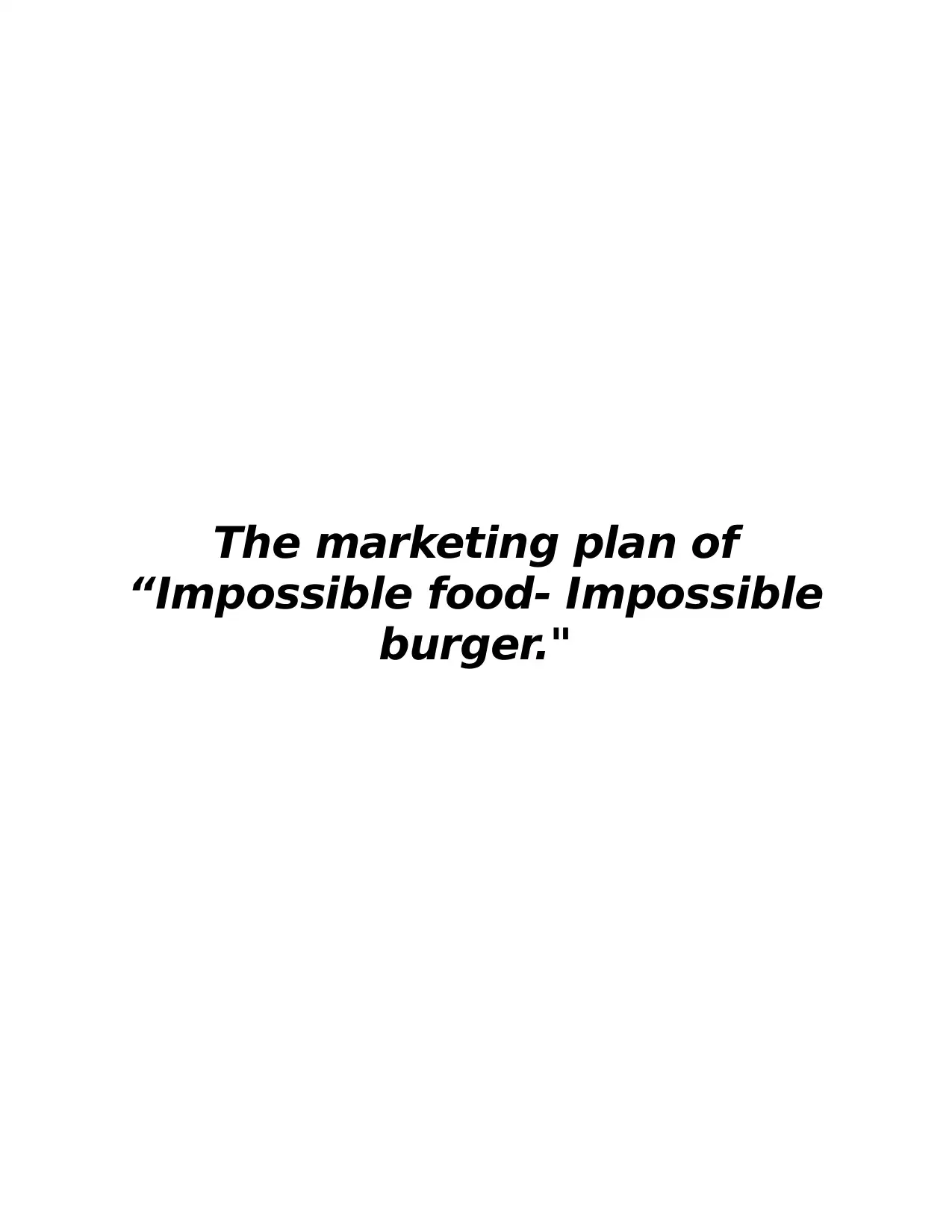
The marketing plan of
“Impossible food- Impossible
burger."
“Impossible food- Impossible
burger."
Secure Best Marks with AI Grader
Need help grading? Try our AI Grader for instant feedback on your assignments.
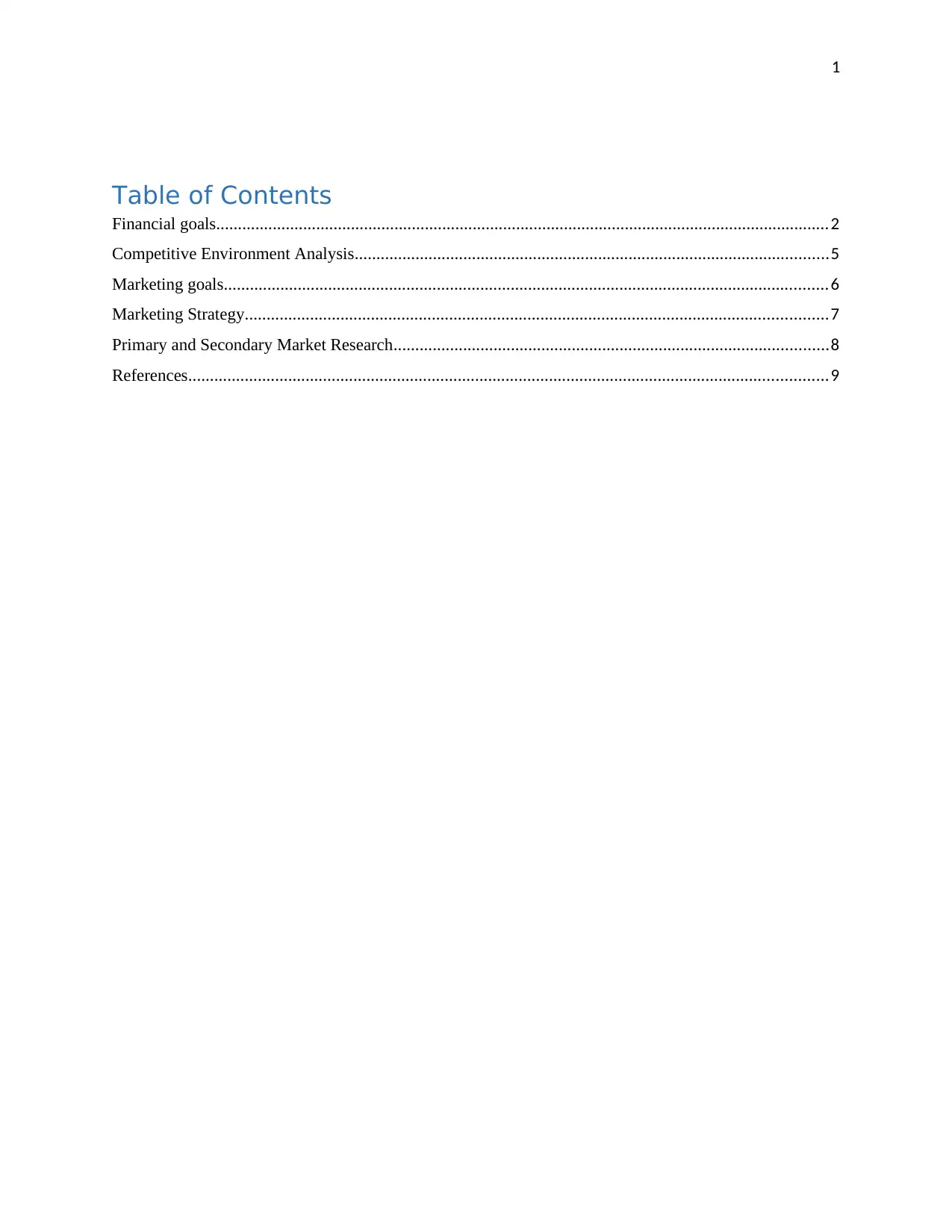
1
Table of Contents
Financial goals.............................................................................................................................................2
Competitive Environment Analysis.............................................................................................................5
Marketing goals...........................................................................................................................................6
Marketing Strategy......................................................................................................................................7
Primary and Secondary Market Research....................................................................................................8
References...................................................................................................................................................9
Table of Contents
Financial goals.............................................................................................................................................2
Competitive Environment Analysis.............................................................................................................5
Marketing goals...........................................................................................................................................6
Marketing Strategy......................................................................................................................................7
Primary and Secondary Market Research....................................................................................................8
References...................................................................................................................................................9
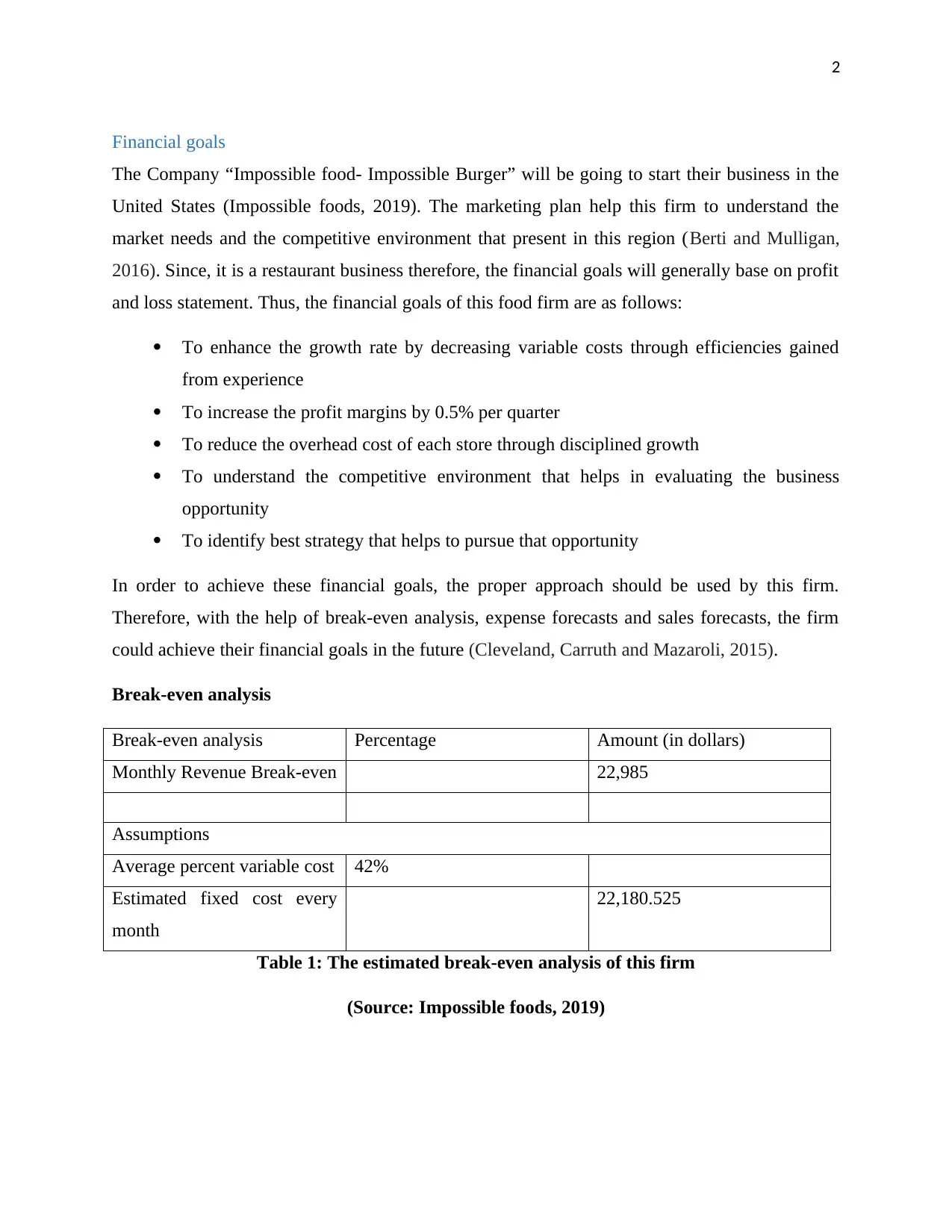
2
Financial goals
The Company “Impossible food- Impossible Burger” will be going to start their business in the
United States (Impossible foods, 2019). The marketing plan help this firm to understand the
market needs and the competitive environment that present in this region (Berti and Mulligan,
2016). Since, it is a restaurant business therefore, the financial goals will generally base on profit
and loss statement. Thus, the financial goals of this food firm are as follows:
To enhance the growth rate by decreasing variable costs through efficiencies gained
from experience
To increase the profit margins by 0.5% per quarter
To reduce the overhead cost of each store through disciplined growth
To understand the competitive environment that helps in evaluating the business
opportunity
To identify best strategy that helps to pursue that opportunity
In order to achieve these financial goals, the proper approach should be used by this firm.
Therefore, with the help of break-even analysis, expense forecasts and sales forecasts, the firm
could achieve their financial goals in the future (Cleveland, Carruth and Mazaroli, 2015).
Break-even analysis
Break-even analysis Percentage Amount (in dollars)
Monthly Revenue Break-even 22,985
Assumptions
Average percent variable cost 42%
Estimated fixed cost every
month
22,180.525
Table 1: The estimated break-even analysis of this firm
(Source: Impossible foods, 2019)
Financial goals
The Company “Impossible food- Impossible Burger” will be going to start their business in the
United States (Impossible foods, 2019). The marketing plan help this firm to understand the
market needs and the competitive environment that present in this region (Berti and Mulligan,
2016). Since, it is a restaurant business therefore, the financial goals will generally base on profit
and loss statement. Thus, the financial goals of this food firm are as follows:
To enhance the growth rate by decreasing variable costs through efficiencies gained
from experience
To increase the profit margins by 0.5% per quarter
To reduce the overhead cost of each store through disciplined growth
To understand the competitive environment that helps in evaluating the business
opportunity
To identify best strategy that helps to pursue that opportunity
In order to achieve these financial goals, the proper approach should be used by this firm.
Therefore, with the help of break-even analysis, expense forecasts and sales forecasts, the firm
could achieve their financial goals in the future (Cleveland, Carruth and Mazaroli, 2015).
Break-even analysis
Break-even analysis Percentage Amount (in dollars)
Monthly Revenue Break-even 22,985
Assumptions
Average percent variable cost 42%
Estimated fixed cost every
month
22,180.525
Table 1: The estimated break-even analysis of this firm
(Source: Impossible foods, 2019)
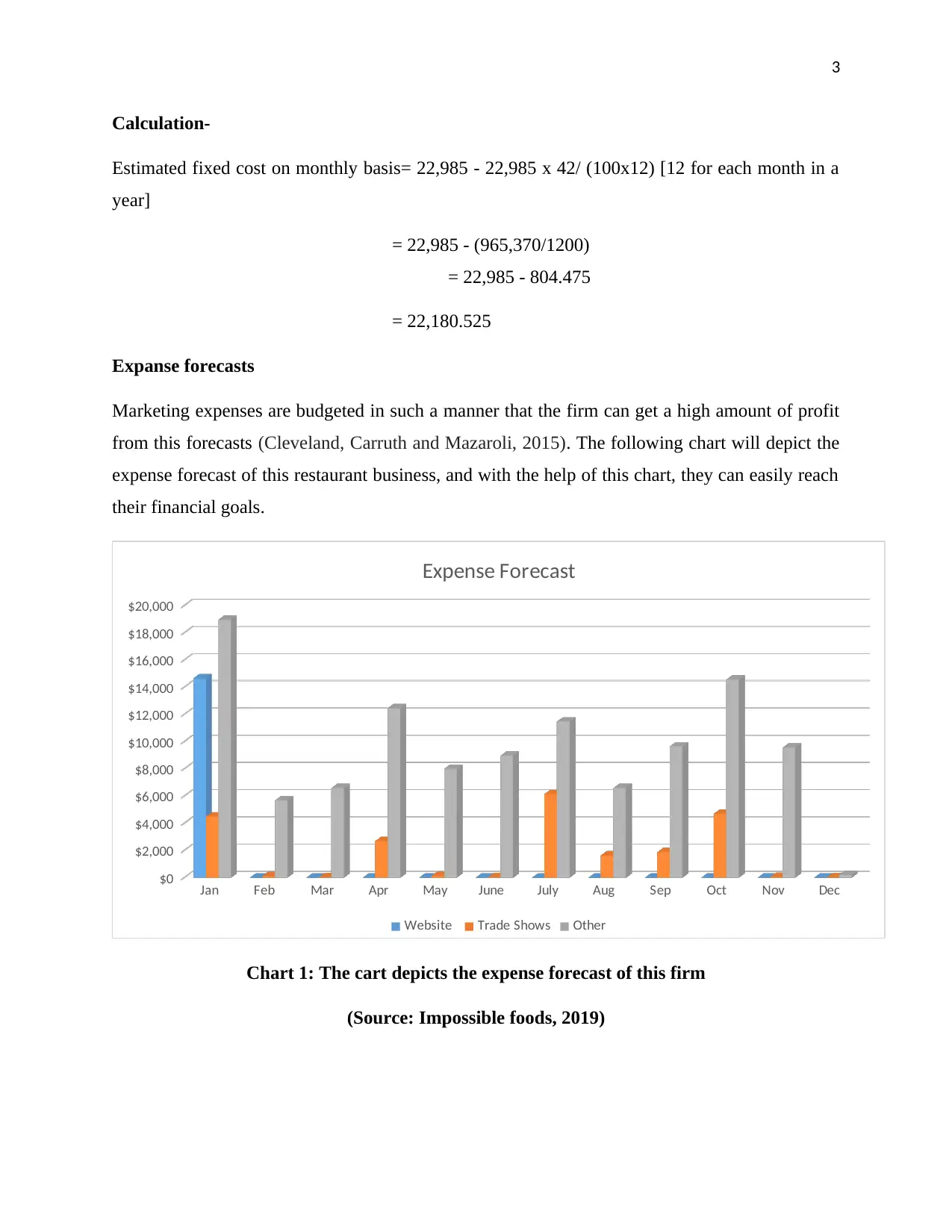
3
Calculation-
Estimated fixed cost on monthly basis= 22,985 - 22,985 x 42/ (100x12) [12 for each month in a
year]
= 22,985 - (965,370/1200)
= 22,985 - 804.475
= 22,180.525
Expanse forecasts
Marketing expenses are budgeted in such a manner that the firm can get a high amount of profit
from this forecasts (Cleveland, Carruth and Mazaroli, 2015). The following chart will depict the
expense forecast of this restaurant business, and with the help of this chart, they can easily reach
their financial goals.
Jan Feb Mar Apr May June July Aug Sep Oct Nov Dec
$0
$2,000
$4,000
$6,000
$8,000
$10,000
$12,000
$14,000
$16,000
$18,000
$20,000
Expense Forecast
Website Trade Shows Other
Chart 1: The cart depicts the expense forecast of this firm
(Source: Impossible foods, 2019)
Calculation-
Estimated fixed cost on monthly basis= 22,985 - 22,985 x 42/ (100x12) [12 for each month in a
year]
= 22,985 - (965,370/1200)
= 22,985 - 804.475
= 22,180.525
Expanse forecasts
Marketing expenses are budgeted in such a manner that the firm can get a high amount of profit
from this forecasts (Cleveland, Carruth and Mazaroli, 2015). The following chart will depict the
expense forecast of this restaurant business, and with the help of this chart, they can easily reach
their financial goals.
Jan Feb Mar Apr May June July Aug Sep Oct Nov Dec
$0
$2,000
$4,000
$6,000
$8,000
$10,000
$12,000
$14,000
$16,000
$18,000
$20,000
Expense Forecast
Website Trade Shows Other
Chart 1: The cart depicts the expense forecast of this firm
(Source: Impossible foods, 2019)
Secure Best Marks with AI Grader
Need help grading? Try our AI Grader for instant feedback on your assignments.
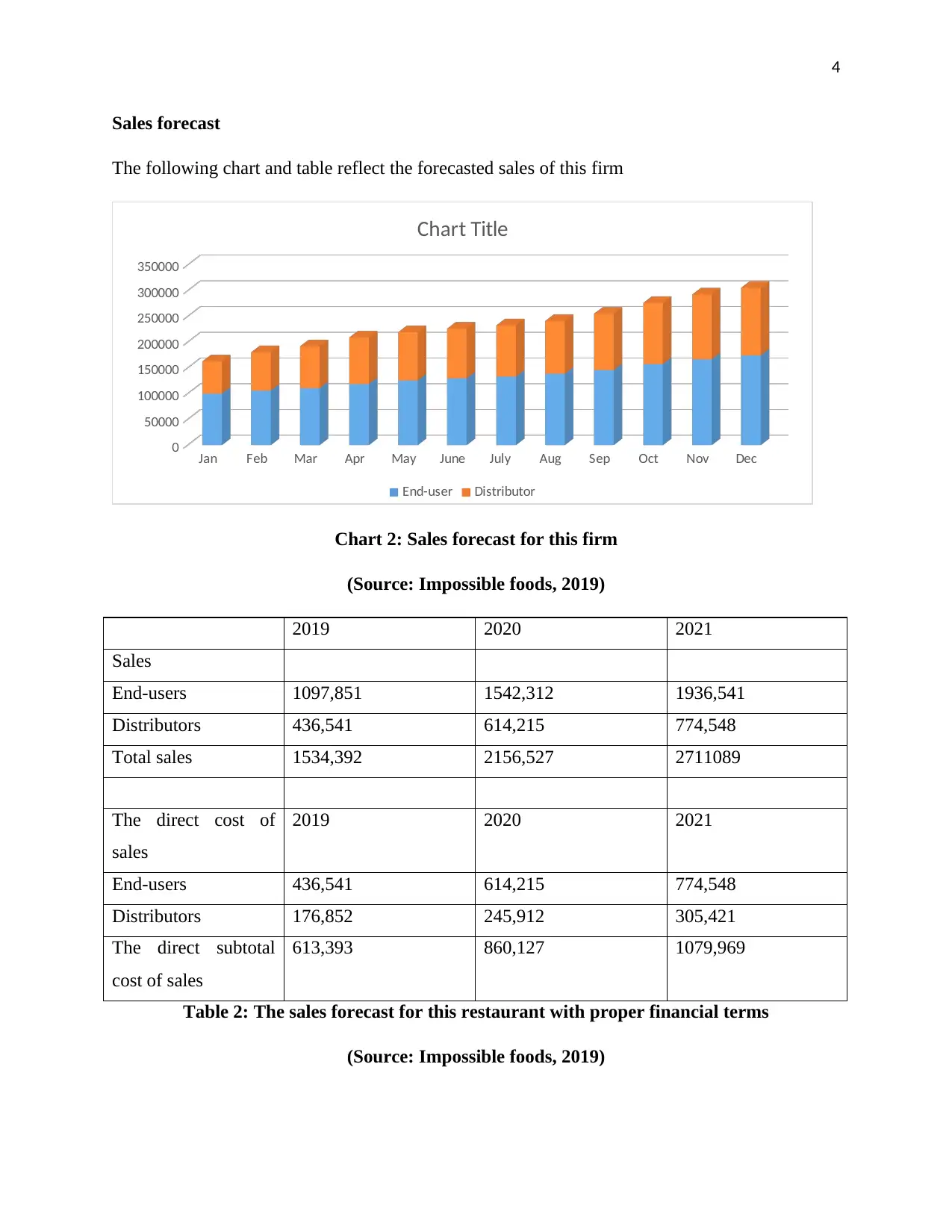
4
Sales forecast
The following chart and table reflect the forecasted sales of this firm
Jan Feb Mar Apr May June July Aug Sep Oct Nov Dec
0
50000
100000
150000
200000
250000
300000
350000
Chart Title
End-user Distributor
Chart 2: Sales forecast for this firm
(Source: Impossible foods, 2019)
2019 2020 2021
Sales
End-users 1097,851 1542,312 1936,541
Distributors 436,541 614,215 774,548
Total sales 1534,392 2156,527 2711089
The direct cost of
sales
2019 2020 2021
End-users 436,541 614,215 774,548
Distributors 176,852 245,912 305,421
The direct subtotal
cost of sales
613,393 860,127 1079,969
Table 2: The sales forecast for this restaurant with proper financial terms
(Source: Impossible foods, 2019)
Sales forecast
The following chart and table reflect the forecasted sales of this firm
Jan Feb Mar Apr May June July Aug Sep Oct Nov Dec
0
50000
100000
150000
200000
250000
300000
350000
Chart Title
End-user Distributor
Chart 2: Sales forecast for this firm
(Source: Impossible foods, 2019)
2019 2020 2021
Sales
End-users 1097,851 1542,312 1936,541
Distributors 436,541 614,215 774,548
Total sales 1534,392 2156,527 2711089
The direct cost of
sales
2019 2020 2021
End-users 436,541 614,215 774,548
Distributors 176,852 245,912 305,421
The direct subtotal
cost of sales
613,393 860,127 1079,969
Table 2: The sales forecast for this restaurant with proper financial terms
(Source: Impossible foods, 2019)
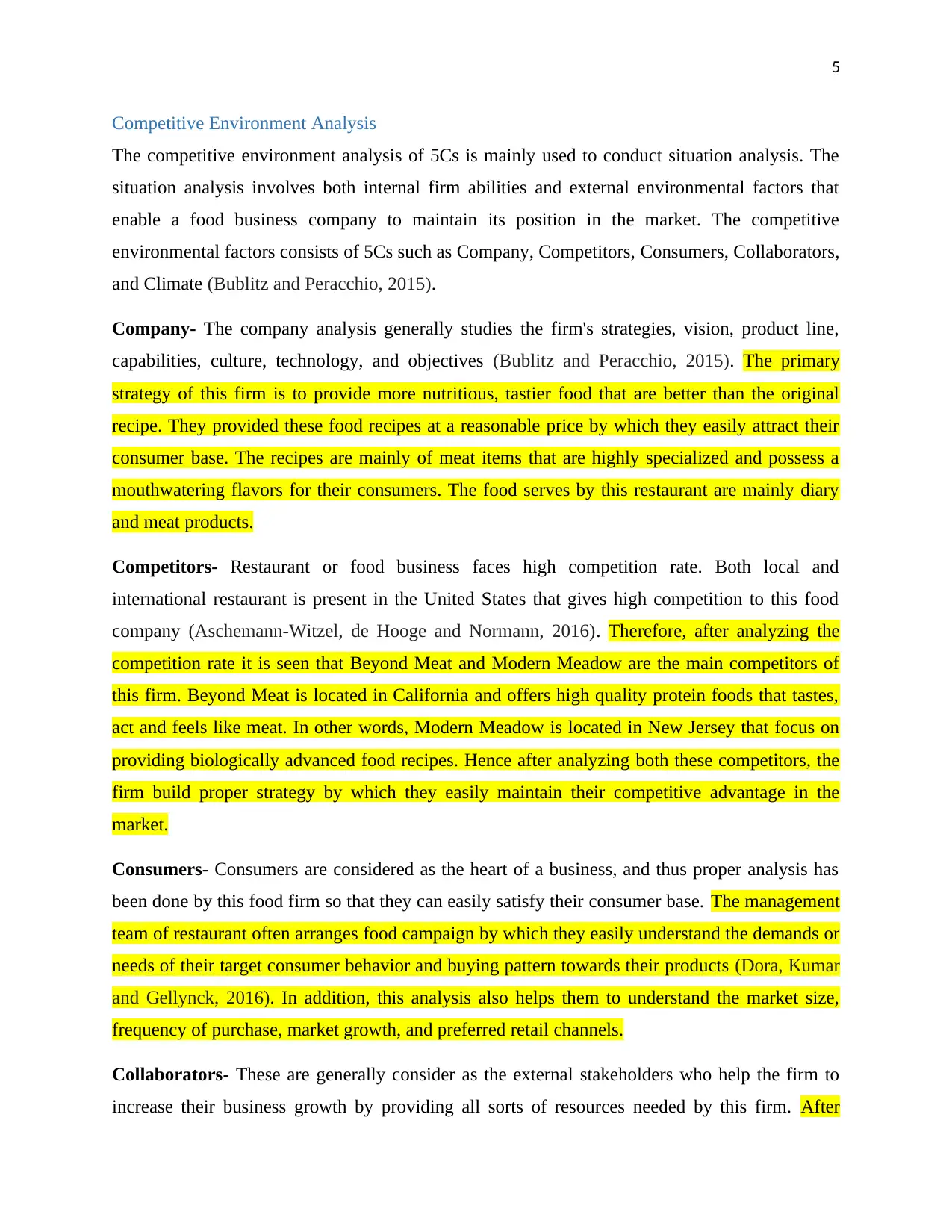
5
Competitive Environment Analysis
The competitive environment analysis of 5Cs is mainly used to conduct situation analysis. The
situation analysis involves both internal firm abilities and external environmental factors that
enable a food business company to maintain its position in the market. The competitive
environmental factors consists of 5Cs such as Company, Competitors, Consumers, Collaborators,
and Climate (Bublitz and Peracchio, 2015).
Company- The company analysis generally studies the firm's strategies, vision, product line,
capabilities, culture, technology, and objectives (Bublitz and Peracchio, 2015). The primary
strategy of this firm is to provide more nutritious, tastier food that are better than the original
recipe. They provided these food recipes at a reasonable price by which they easily attract their
consumer base. The recipes are mainly of meat items that are highly specialized and possess a
mouthwatering flavors for their consumers. The food serves by this restaurant are mainly diary
and meat products.
Competitors- Restaurant or food business faces high competition rate. Both local and
international restaurant is present in the United States that gives high competition to this food
company (Aschemann-Witzel, de Hooge and Normann, 2016). Therefore, after analyzing the
competition rate it is seen that Beyond Meat and Modern Meadow are the main competitors of
this firm. Beyond Meat is located in California and offers high quality protein foods that tastes,
act and feels like meat. In other words, Modern Meadow is located in New Jersey that focus on
providing biologically advanced food recipes. Hence after analyzing both these competitors, the
firm build proper strategy by which they easily maintain their competitive advantage in the
market.
Consumers- Consumers are considered as the heart of a business, and thus proper analysis has
been done by this food firm so that they can easily satisfy their consumer base. The management
team of restaurant often arranges food campaign by which they easily understand the demands or
needs of their target consumer behavior and buying pattern towards their products (Dora, Kumar
and Gellynck, 2016). In addition, this analysis also helps them to understand the market size,
frequency of purchase, market growth, and preferred retail channels.
Collaborators- These are generally consider as the external stakeholders who help the firm to
increase their business growth by providing all sorts of resources needed by this firm. After
Competitive Environment Analysis
The competitive environment analysis of 5Cs is mainly used to conduct situation analysis. The
situation analysis involves both internal firm abilities and external environmental factors that
enable a food business company to maintain its position in the market. The competitive
environmental factors consists of 5Cs such as Company, Competitors, Consumers, Collaborators,
and Climate (Bublitz and Peracchio, 2015).
Company- The company analysis generally studies the firm's strategies, vision, product line,
capabilities, culture, technology, and objectives (Bublitz and Peracchio, 2015). The primary
strategy of this firm is to provide more nutritious, tastier food that are better than the original
recipe. They provided these food recipes at a reasonable price by which they easily attract their
consumer base. The recipes are mainly of meat items that are highly specialized and possess a
mouthwatering flavors for their consumers. The food serves by this restaurant are mainly diary
and meat products.
Competitors- Restaurant or food business faces high competition rate. Both local and
international restaurant is present in the United States that gives high competition to this food
company (Aschemann-Witzel, de Hooge and Normann, 2016). Therefore, after analyzing the
competition rate it is seen that Beyond Meat and Modern Meadow are the main competitors of
this firm. Beyond Meat is located in California and offers high quality protein foods that tastes,
act and feels like meat. In other words, Modern Meadow is located in New Jersey that focus on
providing biologically advanced food recipes. Hence after analyzing both these competitors, the
firm build proper strategy by which they easily maintain their competitive advantage in the
market.
Consumers- Consumers are considered as the heart of a business, and thus proper analysis has
been done by this food firm so that they can easily satisfy their consumer base. The management
team of restaurant often arranges food campaign by which they easily understand the demands or
needs of their target consumer behavior and buying pattern towards their products (Dora, Kumar
and Gellynck, 2016). In addition, this analysis also helps them to understand the market size,
frequency of purchase, market growth, and preferred retail channels.
Collaborators- These are generally consider as the external stakeholders who help the firm to
increase their business growth by providing all sorts of resources needed by this firm. After
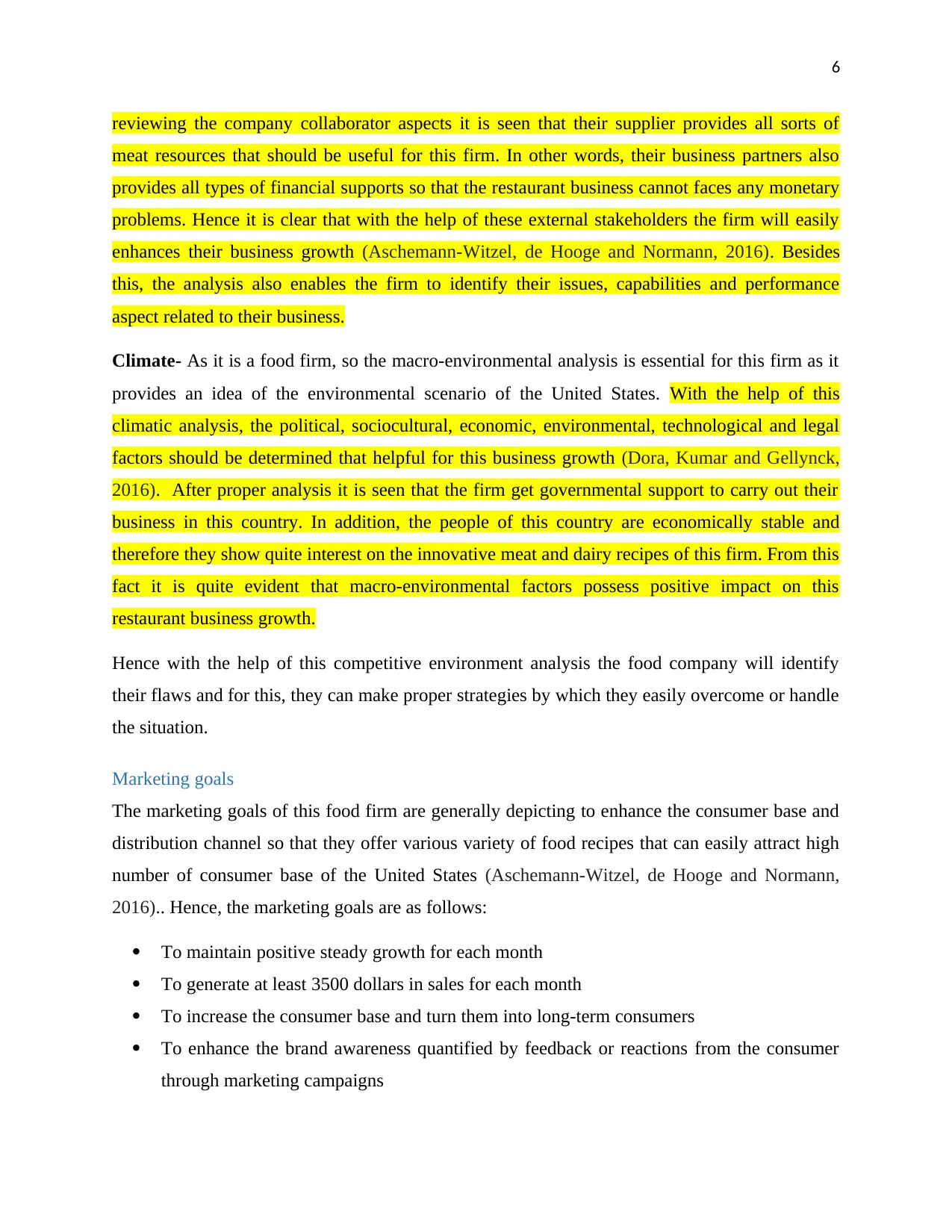
6
reviewing the company collaborator aspects it is seen that their supplier provides all sorts of
meat resources that should be useful for this firm. In other words, their business partners also
provides all types of financial supports so that the restaurant business cannot faces any monetary
problems. Hence it is clear that with the help of these external stakeholders the firm will easily
enhances their business growth (Aschemann-Witzel, de Hooge and Normann, 2016). Besides
this, the analysis also enables the firm to identify their issues, capabilities and performance
aspect related to their business.
Climate- As it is a food firm, so the macro-environmental analysis is essential for this firm as it
provides an idea of the environmental scenario of the United States. With the help of this
climatic analysis, the political, sociocultural, economic, environmental, technological and legal
factors should be determined that helpful for this business growth (Dora, Kumar and Gellynck,
2016). After proper analysis it is seen that the firm get governmental support to carry out their
business in this country. In addition, the people of this country are economically stable and
therefore they show quite interest on the innovative meat and dairy recipes of this firm. From this
fact it is quite evident that macro-environmental factors possess positive impact on this
restaurant business growth.
Hence with the help of this competitive environment analysis the food company will identify
their flaws and for this, they can make proper strategies by which they easily overcome or handle
the situation.
Marketing goals
The marketing goals of this food firm are generally depicting to enhance the consumer base and
distribution channel so that they offer various variety of food recipes that can easily attract high
number of consumer base of the United States (Aschemann-Witzel, de Hooge and Normann,
2016).. Hence, the marketing goals are as follows:
To maintain positive steady growth for each month
To generate at least 3500 dollars in sales for each month
To increase the consumer base and turn them into long-term consumers
To enhance the brand awareness quantified by feedback or reactions from the consumer
through marketing campaigns
reviewing the company collaborator aspects it is seen that their supplier provides all sorts of
meat resources that should be useful for this firm. In other words, their business partners also
provides all types of financial supports so that the restaurant business cannot faces any monetary
problems. Hence it is clear that with the help of these external stakeholders the firm will easily
enhances their business growth (Aschemann-Witzel, de Hooge and Normann, 2016). Besides
this, the analysis also enables the firm to identify their issues, capabilities and performance
aspect related to their business.
Climate- As it is a food firm, so the macro-environmental analysis is essential for this firm as it
provides an idea of the environmental scenario of the United States. With the help of this
climatic analysis, the political, sociocultural, economic, environmental, technological and legal
factors should be determined that helpful for this business growth (Dora, Kumar and Gellynck,
2016). After proper analysis it is seen that the firm get governmental support to carry out their
business in this country. In addition, the people of this country are economically stable and
therefore they show quite interest on the innovative meat and dairy recipes of this firm. From this
fact it is quite evident that macro-environmental factors possess positive impact on this
restaurant business growth.
Hence with the help of this competitive environment analysis the food company will identify
their flaws and for this, they can make proper strategies by which they easily overcome or handle
the situation.
Marketing goals
The marketing goals of this food firm are generally depicting to enhance the consumer base and
distribution channel so that they offer various variety of food recipes that can easily attract high
number of consumer base of the United States (Aschemann-Witzel, de Hooge and Normann,
2016).. Hence, the marketing goals are as follows:
To maintain positive steady growth for each month
To generate at least 3500 dollars in sales for each month
To increase the consumer base and turn them into long-term consumers
To enhance the brand awareness quantified by feedback or reactions from the consumer
through marketing campaigns
Paraphrase This Document
Need a fresh take? Get an instant paraphrase of this document with our AI Paraphraser
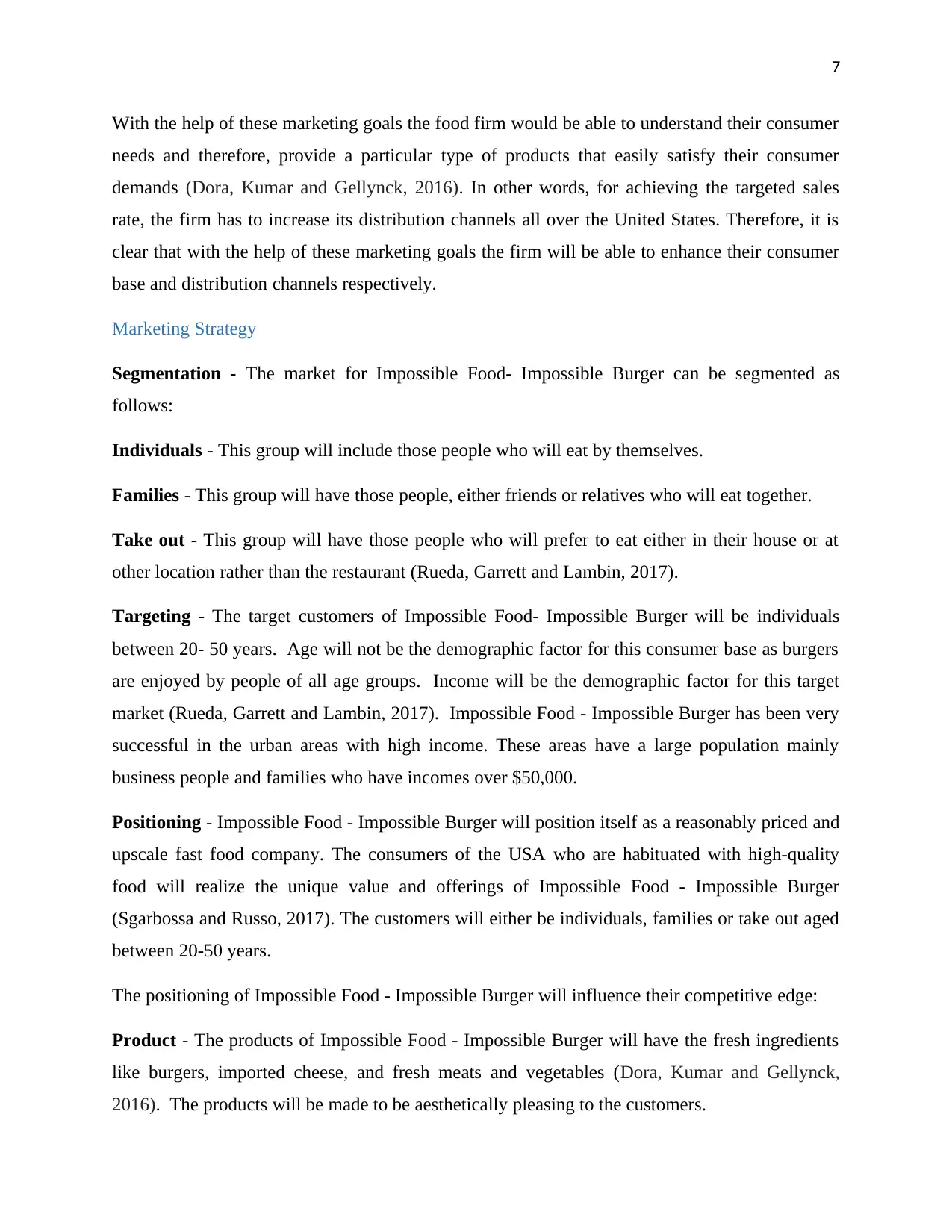
7
With the help of these marketing goals the food firm would be able to understand their consumer
needs and therefore, provide a particular type of products that easily satisfy their consumer
demands (Dora, Kumar and Gellynck, 2016). In other words, for achieving the targeted sales
rate, the firm has to increase its distribution channels all over the United States. Therefore, it is
clear that with the help of these marketing goals the firm will be able to enhance their consumer
base and distribution channels respectively.
Marketing Strategy
Segmentation - The market for Impossible Food- Impossible Burger can be segmented as
follows:
Individuals - This group will include those people who will eat by themselves.
Families - This group will have those people, either friends or relatives who will eat together.
Take out - This group will have those people who will prefer to eat either in their house or at
other location rather than the restaurant (Rueda, Garrett and Lambin, 2017).
Targeting - The target customers of Impossible Food- Impossible Burger will be individuals
between 20- 50 years. Age will not be the demographic factor for this consumer base as burgers
are enjoyed by people of all age groups. Income will be the demographic factor for this target
market (Rueda, Garrett and Lambin, 2017). Impossible Food - Impossible Burger has been very
successful in the urban areas with high income. These areas have a large population mainly
business people and families who have incomes over $50,000.
Positioning - Impossible Food - Impossible Burger will position itself as a reasonably priced and
upscale fast food company. The consumers of the USA who are habituated with high-quality
food will realize the unique value and offerings of Impossible Food - Impossible Burger
(Sgarbossa and Russo, 2017). The customers will either be individuals, families or take out aged
between 20-50 years.
The positioning of Impossible Food - Impossible Burger will influence their competitive edge:
Product - The products of Impossible Food - Impossible Burger will have the fresh ingredients
like burgers, imported cheese, and fresh meats and vegetables (Dora, Kumar and Gellynck,
2016). The products will be made to be aesthetically pleasing to the customers.
With the help of these marketing goals the food firm would be able to understand their consumer
needs and therefore, provide a particular type of products that easily satisfy their consumer
demands (Dora, Kumar and Gellynck, 2016). In other words, for achieving the targeted sales
rate, the firm has to increase its distribution channels all over the United States. Therefore, it is
clear that with the help of these marketing goals the firm will be able to enhance their consumer
base and distribution channels respectively.
Marketing Strategy
Segmentation - The market for Impossible Food- Impossible Burger can be segmented as
follows:
Individuals - This group will include those people who will eat by themselves.
Families - This group will have those people, either friends or relatives who will eat together.
Take out - This group will have those people who will prefer to eat either in their house or at
other location rather than the restaurant (Rueda, Garrett and Lambin, 2017).
Targeting - The target customers of Impossible Food- Impossible Burger will be individuals
between 20- 50 years. Age will not be the demographic factor for this consumer base as burgers
are enjoyed by people of all age groups. Income will be the demographic factor for this target
market (Rueda, Garrett and Lambin, 2017). Impossible Food - Impossible Burger has been very
successful in the urban areas with high income. These areas have a large population mainly
business people and families who have incomes over $50,000.
Positioning - Impossible Food - Impossible Burger will position itself as a reasonably priced and
upscale fast food company. The consumers of the USA who are habituated with high-quality
food will realize the unique value and offerings of Impossible Food - Impossible Burger
(Sgarbossa and Russo, 2017). The customers will either be individuals, families or take out aged
between 20-50 years.
The positioning of Impossible Food - Impossible Burger will influence their competitive edge:
Product - The products of Impossible Food - Impossible Burger will have the fresh ingredients
like burgers, imported cheese, and fresh meats and vegetables (Dora, Kumar and Gellynck,
2016). The products will be made to be aesthetically pleasing to the customers.
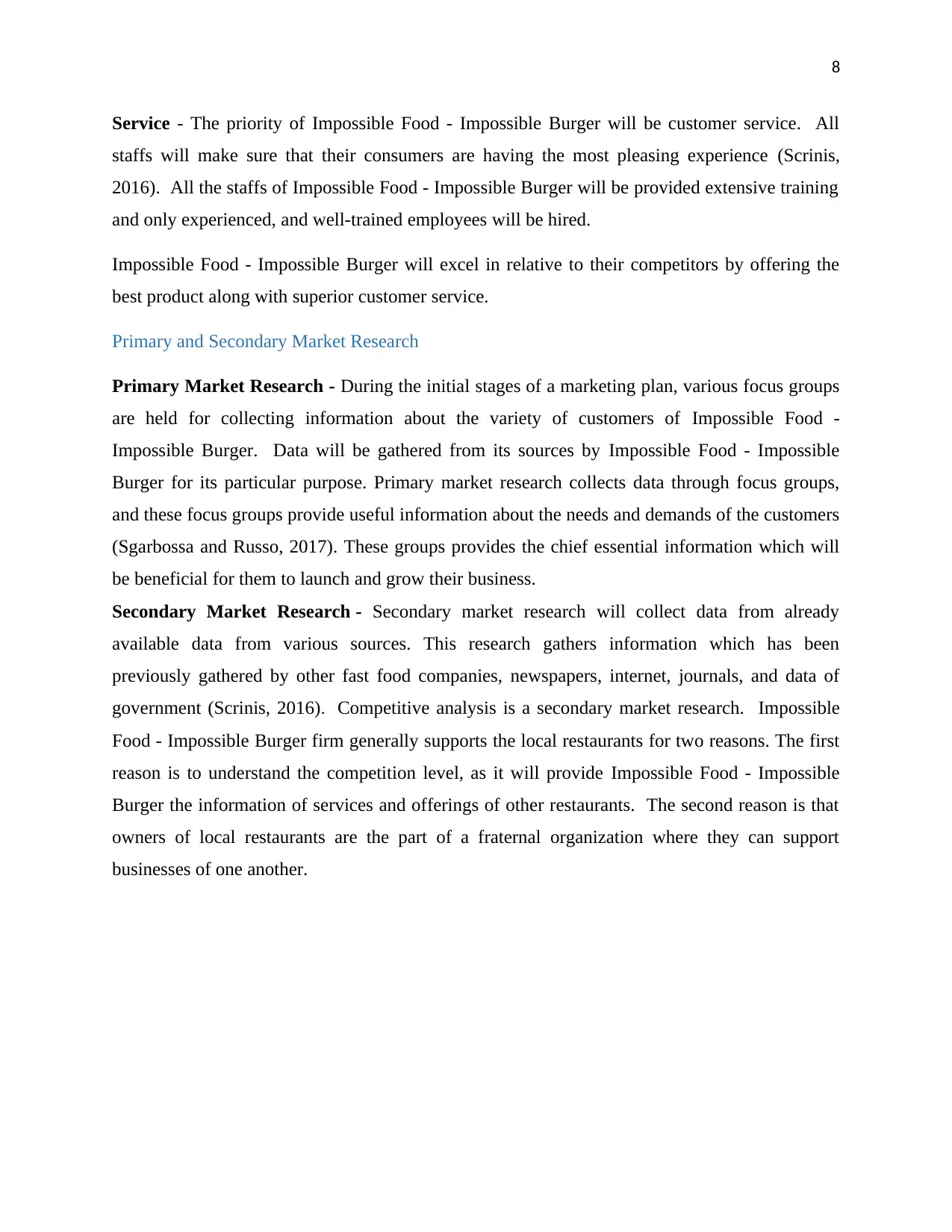
8
Service - The priority of Impossible Food - Impossible Burger will be customer service. All
staffs will make sure that their consumers are having the most pleasing experience (Scrinis,
2016). All the staffs of Impossible Food - Impossible Burger will be provided extensive training
and only experienced, and well-trained employees will be hired.
Impossible Food - Impossible Burger will excel in relative to their competitors by offering the
best product along with superior customer service.
Primary and Secondary Market Research
Primary Market Research - During the initial stages of a marketing plan, various focus groups
are held for collecting information about the variety of customers of Impossible Food -
Impossible Burger. Data will be gathered from its sources by Impossible Food - Impossible
Burger for its particular purpose. Primary market research collects data through focus groups,
and these focus groups provide useful information about the needs and demands of the customers
(Sgarbossa and Russo, 2017). These groups provides the chief essential information which will
be beneficial for them to launch and grow their business.
Secondary Market Research - Secondary market research will collect data from already
available data from various sources. This research gathers information which has been
previously gathered by other fast food companies, newspapers, internet, journals, and data of
government (Scrinis, 2016). Competitive analysis is a secondary market research. Impossible
Food - Impossible Burger firm generally supports the local restaurants for two reasons. The first
reason is to understand the competition level, as it will provide Impossible Food - Impossible
Burger the information of services and offerings of other restaurants. The second reason is that
owners of local restaurants are the part of a fraternal organization where they can support
businesses of one another.
Service - The priority of Impossible Food - Impossible Burger will be customer service. All
staffs will make sure that their consumers are having the most pleasing experience (Scrinis,
2016). All the staffs of Impossible Food - Impossible Burger will be provided extensive training
and only experienced, and well-trained employees will be hired.
Impossible Food - Impossible Burger will excel in relative to their competitors by offering the
best product along with superior customer service.
Primary and Secondary Market Research
Primary Market Research - During the initial stages of a marketing plan, various focus groups
are held for collecting information about the variety of customers of Impossible Food -
Impossible Burger. Data will be gathered from its sources by Impossible Food - Impossible
Burger for its particular purpose. Primary market research collects data through focus groups,
and these focus groups provide useful information about the needs and demands of the customers
(Sgarbossa and Russo, 2017). These groups provides the chief essential information which will
be beneficial for them to launch and grow their business.
Secondary Market Research - Secondary market research will collect data from already
available data from various sources. This research gathers information which has been
previously gathered by other fast food companies, newspapers, internet, journals, and data of
government (Scrinis, 2016). Competitive analysis is a secondary market research. Impossible
Food - Impossible Burger firm generally supports the local restaurants for two reasons. The first
reason is to understand the competition level, as it will provide Impossible Food - Impossible
Burger the information of services and offerings of other restaurants. The second reason is that
owners of local restaurants are the part of a fraternal organization where they can support
businesses of one another.
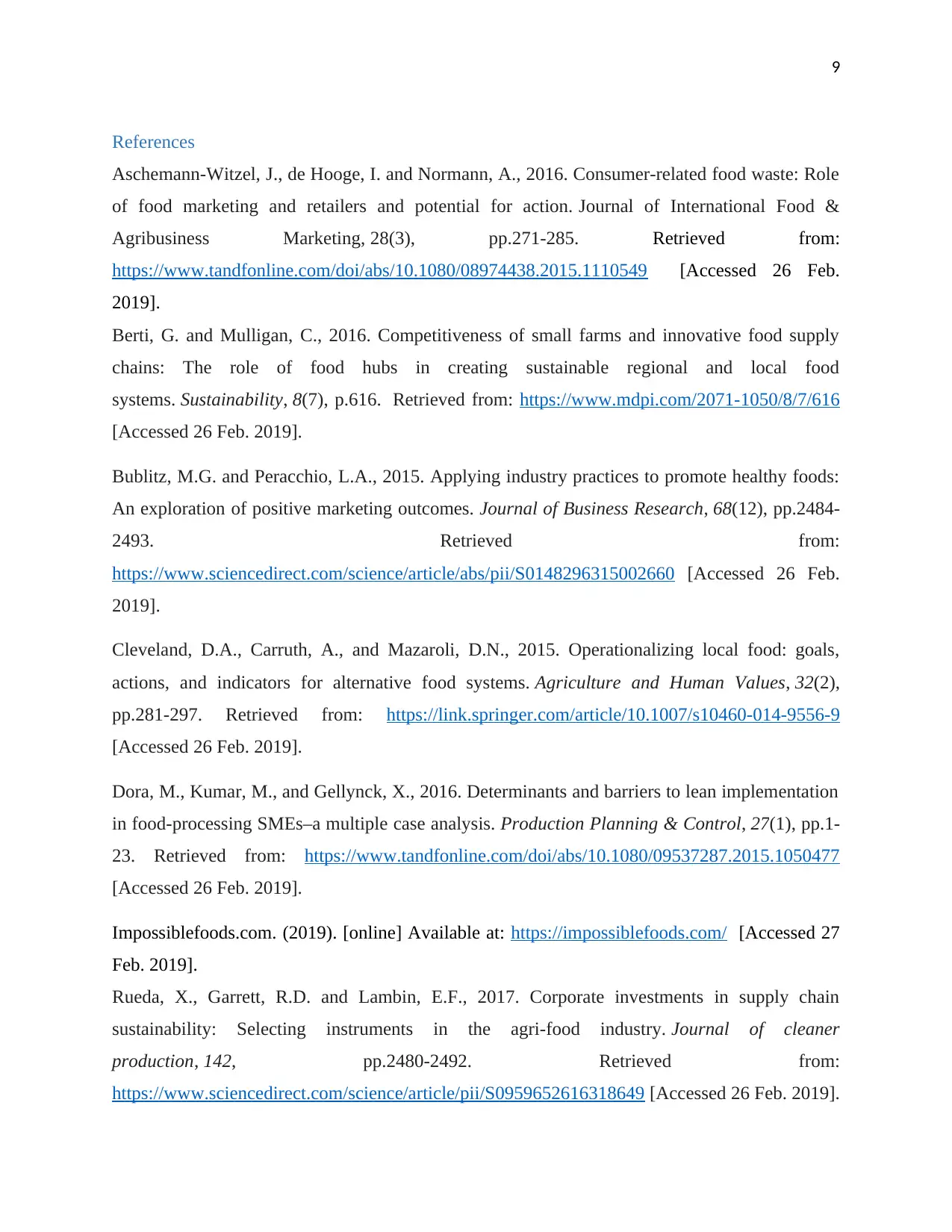
9
References
Aschemann-Witzel, J., de Hooge, I. and Normann, A., 2016. Consumer-related food waste: Role
of food marketing and retailers and potential for action. Journal of International Food &
Agribusiness Marketing, 28(3), pp.271-285. Retrieved from:
https://www.tandfonline.com/doi/abs/10.1080/08974438.2015.1110549 [Accessed 26 Feb.
2019].
Berti, G. and Mulligan, C., 2016. Competitiveness of small farms and innovative food supply
chains: The role of food hubs in creating sustainable regional and local food
systems. Sustainability, 8(7), p.616. Retrieved from: https://www.mdpi.com/2071-1050/8/7/616
[Accessed 26 Feb. 2019].
Bublitz, M.G. and Peracchio, L.A., 2015. Applying industry practices to promote healthy foods:
An exploration of positive marketing outcomes. Journal of Business Research, 68(12), pp.2484-
2493. Retrieved from:
https://www.sciencedirect.com/science/article/abs/pii/S0148296315002660 [Accessed 26 Feb.
2019].
Cleveland, D.A., Carruth, A., and Mazaroli, D.N., 2015. Operationalizing local food: goals,
actions, and indicators for alternative food systems. Agriculture and Human Values, 32(2),
pp.281-297. Retrieved from: https://link.springer.com/article/10.1007/s10460-014-9556-9
[Accessed 26 Feb. 2019].
Dora, M., Kumar, M., and Gellynck, X., 2016. Determinants and barriers to lean implementation
in food-processing SMEs–a multiple case analysis. Production Planning & Control, 27(1), pp.1-
23. Retrieved from: https://www.tandfonline.com/doi/abs/10.1080/09537287.2015.1050477
[Accessed 26 Feb. 2019].
Impossiblefoods.com. (2019). [online] Available at: https://impossiblefoods.com/ [Accessed 27
Feb. 2019].
Rueda, X., Garrett, R.D. and Lambin, E.F., 2017. Corporate investments in supply chain
sustainability: Selecting instruments in the agri-food industry. Journal of cleaner
production, 142, pp.2480-2492. Retrieved from:
https://www.sciencedirect.com/science/article/pii/S0959652616318649 [Accessed 26 Feb. 2019].
References
Aschemann-Witzel, J., de Hooge, I. and Normann, A., 2016. Consumer-related food waste: Role
of food marketing and retailers and potential for action. Journal of International Food &
Agribusiness Marketing, 28(3), pp.271-285. Retrieved from:
https://www.tandfonline.com/doi/abs/10.1080/08974438.2015.1110549 [Accessed 26 Feb.
2019].
Berti, G. and Mulligan, C., 2016. Competitiveness of small farms and innovative food supply
chains: The role of food hubs in creating sustainable regional and local food
systems. Sustainability, 8(7), p.616. Retrieved from: https://www.mdpi.com/2071-1050/8/7/616
[Accessed 26 Feb. 2019].
Bublitz, M.G. and Peracchio, L.A., 2015. Applying industry practices to promote healthy foods:
An exploration of positive marketing outcomes. Journal of Business Research, 68(12), pp.2484-
2493. Retrieved from:
https://www.sciencedirect.com/science/article/abs/pii/S0148296315002660 [Accessed 26 Feb.
2019].
Cleveland, D.A., Carruth, A., and Mazaroli, D.N., 2015. Operationalizing local food: goals,
actions, and indicators for alternative food systems. Agriculture and Human Values, 32(2),
pp.281-297. Retrieved from: https://link.springer.com/article/10.1007/s10460-014-9556-9
[Accessed 26 Feb. 2019].
Dora, M., Kumar, M., and Gellynck, X., 2016. Determinants and barriers to lean implementation
in food-processing SMEs–a multiple case analysis. Production Planning & Control, 27(1), pp.1-
23. Retrieved from: https://www.tandfonline.com/doi/abs/10.1080/09537287.2015.1050477
[Accessed 26 Feb. 2019].
Impossiblefoods.com. (2019). [online] Available at: https://impossiblefoods.com/ [Accessed 27
Feb. 2019].
Rueda, X., Garrett, R.D. and Lambin, E.F., 2017. Corporate investments in supply chain
sustainability: Selecting instruments in the agri-food industry. Journal of cleaner
production, 142, pp.2480-2492. Retrieved from:
https://www.sciencedirect.com/science/article/pii/S0959652616318649 [Accessed 26 Feb. 2019].
Secure Best Marks with AI Grader
Need help grading? Try our AI Grader for instant feedback on your assignments.
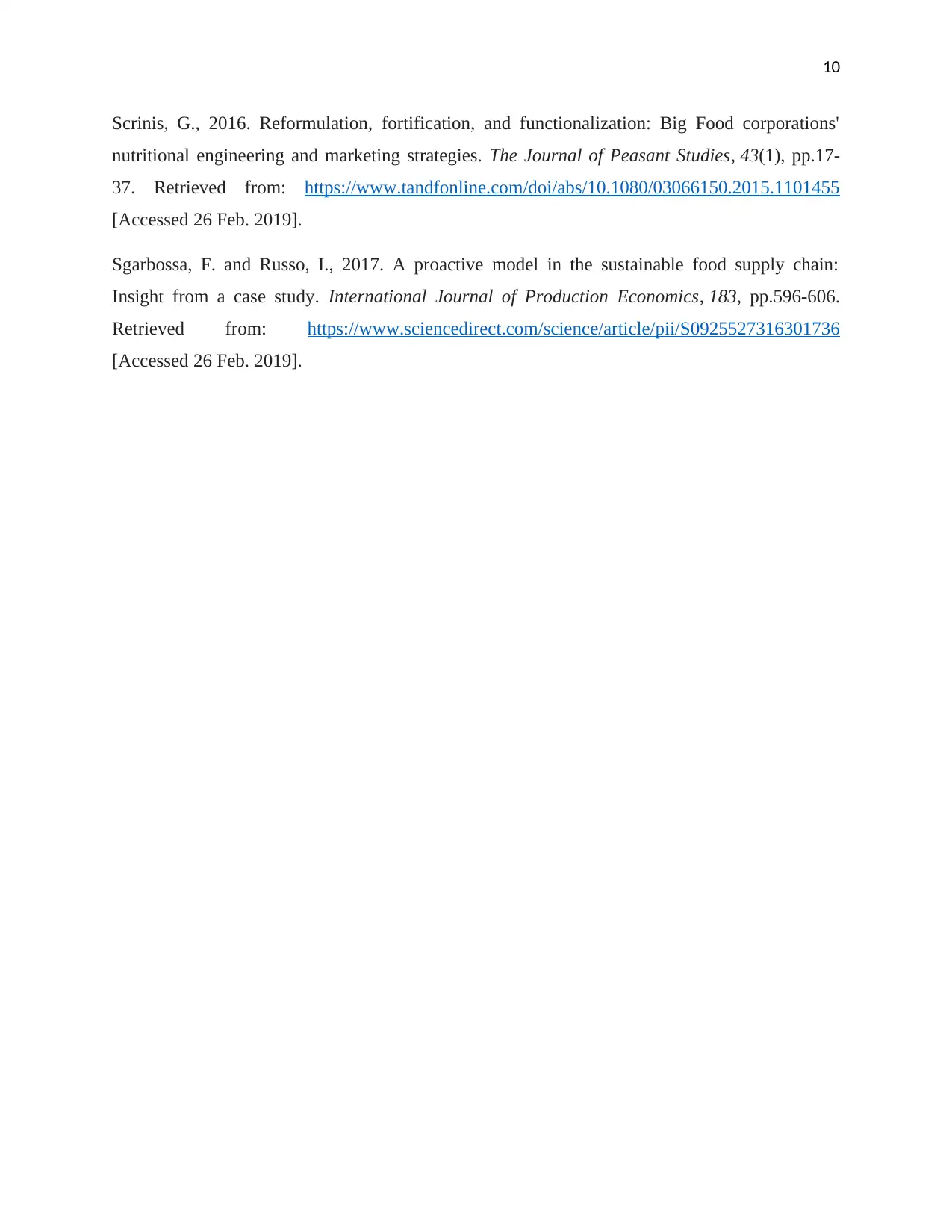
10
Scrinis, G., 2016. Reformulation, fortification, and functionalization: Big Food corporations'
nutritional engineering and marketing strategies. The Journal of Peasant Studies, 43(1), pp.17-
37. Retrieved from: https://www.tandfonline.com/doi/abs/10.1080/03066150.2015.1101455
[Accessed 26 Feb. 2019].
Sgarbossa, F. and Russo, I., 2017. A proactive model in the sustainable food supply chain:
Insight from a case study. International Journal of Production Economics, 183, pp.596-606.
Retrieved from: https://www.sciencedirect.com/science/article/pii/S0925527316301736
[Accessed 26 Feb. 2019].
Scrinis, G., 2016. Reformulation, fortification, and functionalization: Big Food corporations'
nutritional engineering and marketing strategies. The Journal of Peasant Studies, 43(1), pp.17-
37. Retrieved from: https://www.tandfonline.com/doi/abs/10.1080/03066150.2015.1101455
[Accessed 26 Feb. 2019].
Sgarbossa, F. and Russo, I., 2017. A proactive model in the sustainable food supply chain:
Insight from a case study. International Journal of Production Economics, 183, pp.596-606.
Retrieved from: https://www.sciencedirect.com/science/article/pii/S0925527316301736
[Accessed 26 Feb. 2019].
1 out of 11
Related Documents
Your All-in-One AI-Powered Toolkit for Academic Success.
+13062052269
info@desklib.com
Available 24*7 on WhatsApp / Email
![[object Object]](/_next/static/media/star-bottom.7253800d.svg)
Unlock your academic potential
© 2024 | Zucol Services PVT LTD | All rights reserved.





